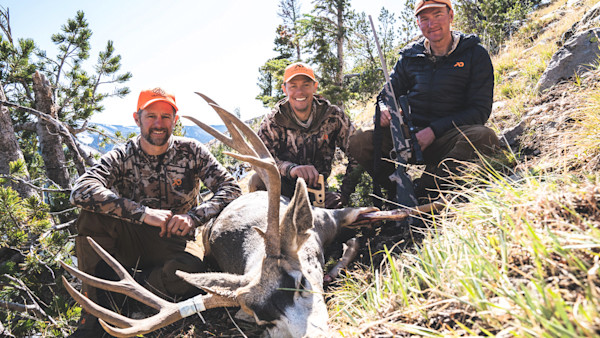
Gramps killed more deer than you’ll ever see without a bipod or hearing protection. You don’t need anything besides an accurate rifle and iron sights to take down America’s favorite big game animal.
The accessories on this list might not be strictly necessary, but they sure are useful—and they’re worth considering as we get ready for the hunting season.
Bipod
The history of bipods is difficult to track down, likely because the concept is so intuitive. It probably took Chinese soldiers all of five minutes to realize their hand cannons were more accurate when steadied on two sticks, and the technology progressed from there.
These days, deer hunters enjoy a host of options that improve on the two-stick technology. You can find bipods for standing, sitting, and prone positions at a variety of price points. Swagger bipods bend and sway for almost unlimited flexibility in the field, and KDC bipods are designed to be the lightest on the market.
Hunters should select the bipod that will be most useful in the likeliest hunting scenario. If you plan to camp out in a tree stand and wait out the season, you probably don’t need one. For medium-range shots in flat country, a sitting bipod might help you see over shrubs or tall grasses. If you spot-and-stalk in hilly terrain, a lightweight prone bipod will almost definitely come in handy.
For that last scenario, I like the Spartan Javelin Lite Bipod. Spartan’s quick-detach system means you can keep it strapped to your pack and out of the way until you need to use it. It only weighs about five ounces and offers 15 degrees of cant and 30 degrees of pan. The legs are not adjustable, but the “standard” (7.2 inches) or “long” (8.7 inches) options should cover the majority of shots in the field.
Sling
Guns aren’t heavy until you’ve been carrying one all day without a sling.
Slings are most useful if you’re covering lots of ground, but they can come in handy even on the walk to the tree stand. A sling keeps your hands free to use a flashlight, tie your boots, or quietly push past a branch.
If you think you’ll need to take a standing shot without shooting sticks, a sling can also help pull the stock into your shoulder and steady your aim. Known as the “hasty sling” technique, the shooter wraps his or her non-dominant arm in the sling and creates a tension that steadies the rifle. Texas Parks & Wildlife has published a pretty good tutorial, which you can check out here.
I’m partial to the Rifle Sling from FHF Gear. The fully adjustable sling is constructed from Cordura fabric and HANK (Neoprene-coated Nylon) for durability and weather resistance, and the closed cell foam shoulder pad is extremely comfortable.
Whitetail hunters don’t often find themselves carrying a large pack, but if you do, FHF’s Rifle Sling also comes with a propriety quick-detach system that lets you attach your rifle to your pack.
Magnification Throw Lever
We’ve all been there. A deer walks out at 45 yards when you look down and realize the Hubble Telescope on your rifle is set at 18x. The thin layer of moisture on the scope’s magnification ring makes it impossible to turn with gloves, and you have a minor heart attack trying to adjust it down to 3x as you watch the deer move out of your shooting lane.
Life is too short to spend it panicking about scope adjustments. That’s why I recommend a magnification throw lever. Made by a variety of companies, a throw lever attaches to your scope’s magnification ring and allows for easy adjustment even with heavy winter gloves.
Some scopes come with aggressively textured adjustment controls, and in that case, you might not need one. But if your scope only has shallow grooves on the controls or is tough to turn without gloves, invest in a throw lever and have a heart attack about something else.
Lens Caps
Lens caps keep rain and dirt off your scope’s lenses so you can see what you’re aiming at. For further explanation, refer to the previous sentence. Many scopes come with lens caps. If yours didn’t, you can buy them from Vortex here (just be sure you order the correct size for your objective lens).
Hearing Protection
Hearing protection isn’t a gun accessory, per se, but only gun hunters need it, so I’m including it on this list.
Gramps didn’t use hearing protection, but now he’s paying for it. Hearing loss ain’t no joke, and as hearing doctor Grace Sturdivant explained recently on the MeatEater podcast, it’s been linked to even worse diseases like Alzheimer’s.
Older hunters had a good excuse to leave their hearing protection at home (they wanted to hear the deer!), but modern technology has rendered that excuse obsolete. Electronic ear muffs can be found for less than $50, and good quality, less obtrusive electronic earbuds run in the $100 to $150 range.
If you’re looking to make an investment in your health (how I justify most gun purchases), custom-fit ear pro from companies like OtoPro offer top-of-the-line hearing protection designed exactly for your ears. They’ll cost you about $275, but they’ll last for years, and you won’t deal with muffling or discomfort.
All these products allow you to hear everything when you’re out in the field while protecting your ears from the concussion of a rifle or shotgun. That ringing in your ears might go away after a few hours, but it means you’ve permanently damaged your hearing. Do that enough times, and that ringing will be there to stay.
Last Shot
You don’t need any of these products to successfully hunt whitetail, but why not make your life a little easier? Hunting can be difficult, and I don’t know about you, but I need all the help I can get.







Conversation